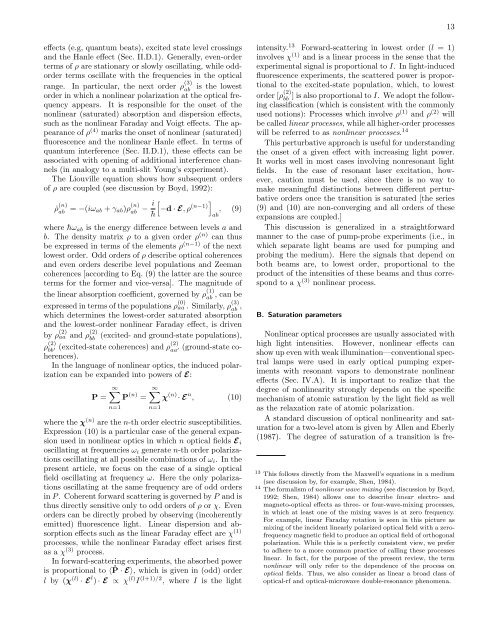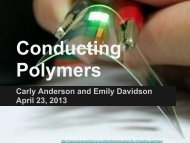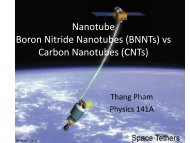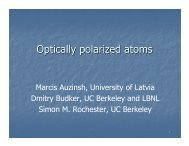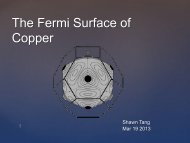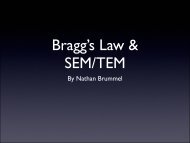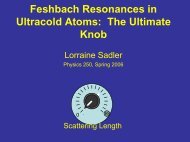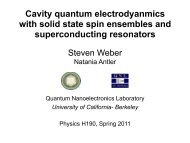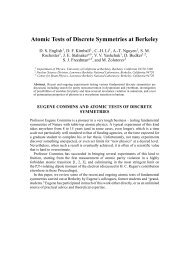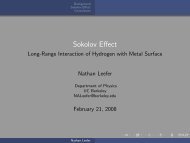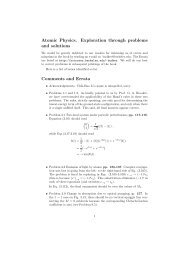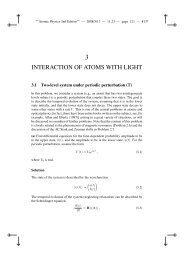Resonant nonlinear magneto-optical effects in atomsâ - The Budker ...
Resonant nonlinear magneto-optical effects in atomsâ - The Budker ...
Resonant nonlinear magneto-optical effects in atomsâ - The Budker ...
Create successful ePaper yourself
Turn your PDF publications into a flip-book with our unique Google optimized e-Paper software.
13<br />
<strong>effects</strong> (e.g, quantum beats), excited state level cross<strong>in</strong>gs<br />
and the Hanle effect (Sec. II.D.1). Generally, even-order<br />
terms of ρ are stationary or slowly oscillat<strong>in</strong>g, while oddorder<br />
terms oscillate with the frequencies <strong>in</strong> the <strong>optical</strong><br />
range. In particular, the next order ρ (3)<br />
ab<br />
is the lowest<br />
order <strong>in</strong> which a <strong>nonl<strong>in</strong>ear</strong> polarization at the <strong>optical</strong> frequency<br />
appears. It is responsible for the onset of the<br />
<strong>nonl<strong>in</strong>ear</strong> (saturated) absorption and dispersion <strong>effects</strong>,<br />
such as the <strong>nonl<strong>in</strong>ear</strong> Faraday and Voigt <strong>effects</strong>. <strong>The</strong> appearance<br />
of ρ (4) marks the onset of <strong>nonl<strong>in</strong>ear</strong> (saturated)<br />
fluorescence and the <strong>nonl<strong>in</strong>ear</strong> Hanle effect. In terms of<br />
quantum <strong>in</strong>terference (Sec. II.D.1), these <strong>effects</strong> can be<br />
associated with open<strong>in</strong>g of additional <strong>in</strong>terference channels<br />
(<strong>in</strong> analogy to a multi-slit Young’s experiment).<br />
<strong>The</strong> Liouville equation shows how subsequent orders<br />
of ρ are coupled (see discussion by Boyd, 1992):<br />
˙ρ (n)<br />
ab<br />
= −(iω ab + γ ab )ρ (n)<br />
ab<br />
− ī h<br />
[<br />
−d · E, ρ (n−1)] ab, (9)<br />
where ¯hω ab is the energy difference between levels a and<br />
b. <strong>The</strong> density matrix ρ to a given order ρ (n) can thus<br />
be expressed <strong>in</strong> terms of the elements ρ (n−1) of the next<br />
lowest order. Odd orders of ρ describe <strong>optical</strong> coherences<br />
and even orders describe level populations and Zeeman<br />
coherences [accord<strong>in</strong>g to Eq. (9) the latter are the source<br />
terms for the former and vice-versa]. <strong>The</strong> magnitude of<br />
the l<strong>in</strong>ear absorption coefficient, governed by ρ (1)<br />
ab<br />
, can be<br />
expressed <strong>in</strong> terms of the populations ρ (0)<br />
aa . Similarly, ρ (3)<br />
ab ,<br />
which determ<strong>in</strong>es the lowest-order saturated absorption<br />
and the lowest-order <strong>nonl<strong>in</strong>ear</strong> Faraday effect, is driven<br />
by ρ (2)<br />
aa and ρ (2)<br />
bb<br />
(excited- and ground-state populations),<br />
ρ (2)<br />
bb<br />
(excited-state coherences) and ρ (2)<br />
′ aa ′ (ground-state coherences).<br />
In the language of <strong>nonl<strong>in</strong>ear</strong> optics, the <strong>in</strong>duced polarization<br />
can be expanded <strong>in</strong>to powers of E:<br />
∞∑<br />
∞∑<br />
P = P (n) = χ (n)· E n , (10)<br />
n=1<br />
n=1<br />
where the χ (n) are the n-th order electric susceptibilities.<br />
Expression (10) is a particular case of the general expansion<br />
used <strong>in</strong> <strong>nonl<strong>in</strong>ear</strong> optics <strong>in</strong> which n <strong>optical</strong> fields E i<br />
oscillat<strong>in</strong>g at frequencies ω i generate n-th order polarizations<br />
oscillat<strong>in</strong>g at all possible comb<strong>in</strong>ations of ω i . In the<br />
present article, we focus on the case of a s<strong>in</strong>gle <strong>optical</strong><br />
field oscillat<strong>in</strong>g at frequency ω. Here the only polarizations<br />
oscillat<strong>in</strong>g at the same frequency are of odd orders<br />
<strong>in</strong> P . Coherent forward scatter<strong>in</strong>g is governed by P and is<br />
thus directly sensitive only to odd orders of ρ or χ. Even<br />
orders can be directly probed by observ<strong>in</strong>g (<strong>in</strong>coherently<br />
emitted) fluorescence light. L<strong>in</strong>ear dispersion and absorption<br />
<strong>effects</strong> such as the l<strong>in</strong>ear Faraday effect are χ (1)<br />
processes, while the <strong>nonl<strong>in</strong>ear</strong> Faraday effect arises first<br />
as a χ (3) process.<br />
In forward-scatter<strong>in</strong>g experiments, the absorbed power<br />
is proportional to 〈Ṗ · E〉, which is given <strong>in</strong> (odd) order<br />
l by (χ (l) · E l ) · E ∝ χ (l) I (l+1)/2 , where I is the light<br />
<strong>in</strong>tensity. 13 Forward-scatter<strong>in</strong>g <strong>in</strong> lowest order (l = 1)<br />
<strong>in</strong>volves χ (1) and is a l<strong>in</strong>ear process <strong>in</strong> the sense that the<br />
experimental signal is proportional to I. In light-<strong>in</strong>duced<br />
fluorescence experiments, the scattered power is proportional<br />
to the excited-state population, which, to lowest<br />
order [ρ (2)<br />
bb<br />
] is also proportional to I. We adopt the follow<strong>in</strong>g<br />
classification (which is consistent with the commonly<br />
used notions): Processes which <strong>in</strong>volve ρ (1) and ρ (2) will<br />
be called l<strong>in</strong>ear processes, while all higher-order processes<br />
will be referred to as <strong>nonl<strong>in</strong>ear</strong> processes. 14<br />
This perturbative approach is useful for understand<strong>in</strong>g<br />
the onset of a given effect with <strong>in</strong>creas<strong>in</strong>g light power.<br />
It works well <strong>in</strong> most cases <strong>in</strong>volv<strong>in</strong>g nonresonant light<br />
fields. In the case of resonant laser excitation, however,<br />
caution must be used, s<strong>in</strong>ce there is no way to<br />
make mean<strong>in</strong>gful dist<strong>in</strong>ctions between different perturbative<br />
orders once the transition is saturated [the series<br />
(9) and (10) are non-converg<strong>in</strong>g and all orders of these<br />
expansions are coupled.]<br />
This discussion is generalized <strong>in</strong> a straightforward<br />
manner to the case of pump-probe experiments (i.e., <strong>in</strong><br />
which separate light beams are used for pump<strong>in</strong>g and<br />
prob<strong>in</strong>g the medium). Here the signals that depend on<br />
both beams are, to lowest order, proportional to the<br />
product of the <strong>in</strong>tensities of these beams and thus correspond<br />
to a χ (3) <strong>nonl<strong>in</strong>ear</strong> process.<br />
B. Saturation parameters<br />
Nonl<strong>in</strong>ear <strong>optical</strong> processes are usually associated with<br />
high light <strong>in</strong>tensities. However, <strong>nonl<strong>in</strong>ear</strong> <strong>effects</strong> can<br />
show up even with weak illum<strong>in</strong>ation—conventional spectral<br />
lamps were used <strong>in</strong> early <strong>optical</strong> pump<strong>in</strong>g experiments<br />
with resonant vapors to demonstrate <strong>nonl<strong>in</strong>ear</strong><br />
<strong>effects</strong> (Sec. IV.A). It is important to realize that the<br />
degree of <strong>nonl<strong>in</strong>ear</strong>ity strongly depends on the specific<br />
mechanism of atomic saturation by the light field as well<br />
as the relaxation rate of atomic polarization.<br />
A standard discussion of <strong>optical</strong> <strong>nonl<strong>in</strong>ear</strong>ity and saturation<br />
for a two-level atom is given by Allen and Eberly<br />
(1987). <strong>The</strong> degree of saturation of a transition is fre-<br />
13 This follows directly from the Maxwell’s equations <strong>in</strong> a medium<br />
(see discussion by, for example, Shen, 1984).<br />
14 <strong>The</strong> formalism of <strong>nonl<strong>in</strong>ear</strong> wave mix<strong>in</strong>g (see discussion by Boyd,<br />
1992; Shen, 1984) allows one to describe l<strong>in</strong>ear electro- and<br />
<strong>magneto</strong>-<strong>optical</strong> <strong>effects</strong> as three- or four-wave-mix<strong>in</strong>g processes,<br />
<strong>in</strong> which at least one of the mix<strong>in</strong>g waves is at zero frequency.<br />
For example, l<strong>in</strong>ear Faraday rotation is seen <strong>in</strong> this picture as<br />
mix<strong>in</strong>g of the <strong>in</strong>cident l<strong>in</strong>early polarized <strong>optical</strong> field with a zerofrequency<br />
magnetic field to produce an <strong>optical</strong> field of orthogonal<br />
polarization. While this is a perfectly consistent view, we prefer<br />
to adhere to a more common practice of call<strong>in</strong>g these processes<br />
l<strong>in</strong>ear. In fact, for the purpose of the present review, the term<br />
<strong>nonl<strong>in</strong>ear</strong> will only refer to the dependence of the process on<br />
<strong>optical</strong> fields. Thus, we also consider as l<strong>in</strong>ear a broad class of<br />
<strong>optical</strong>-rf and <strong>optical</strong>-microwave double-resonance phenomena.


